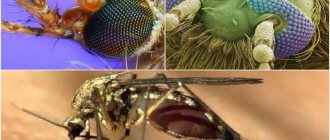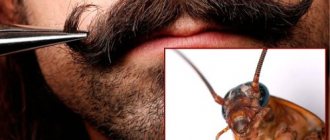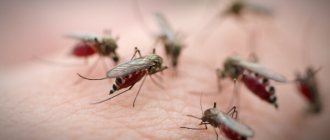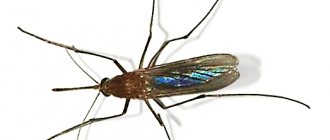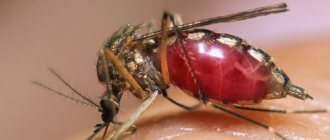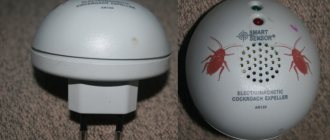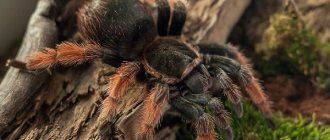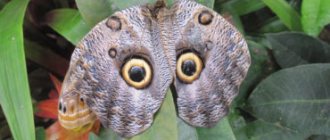Lifespan of mosquitoes
Scientists have found that the lifespan of a common mosquito depends on several factors:
- Habitats.
- Air temperatures.
- Insect feeding.
In this case, the most important factor is the temperature regime of the insect’s life. In addition, it has also been established that female mosquitoes live almost 2 times longer than males, although the reason for this difference has not yet been established by scientists.
So, the life expectancy of a mosquito, or rather its female, will be as follows:
- About 43 days at 25°C
- 58 days – at 20°C.
- 114 days – at 15°C.
- 119 days – at 10°C.
Accordingly, in each of these cases, the male’s life will be half as long.
Cycle of life
The lifespan of a mosquito directly depends on the habitat into which it finds itself after birth. Temperature plays the main role. At +25°C, insects live for about 45 days; at +20°C, the lifespan of a mosquito increases to 60 days. A decrease in temperature below +15°C slows down metabolic processes in the body of adults and larvae, prolonging their existence to 119 days.
On a note!
How long a common mosquito lives depends on its gender. The average life expectancy of a male is 14 days. Genetic ability – 20 days. When talking about timing, they most often mean how long the female lives.
Mosquito breeding
In the wild, mosquitoes drink the blood of animals and reproduce healthy offspring in large numbers. In a humid, moderately warm environment, the mosquito can live for almost 2 months. An increase in indicators from +25 degrees Celsius does not allow insects to rise into the air, as they instantly lose moisture. Whereas, under favorable conditions, mosquitoes reach the 9th floor. A decrease from +10 degrees Celsius helps to slow down metabolic processes, the insect falls into suspended animation, but continues to live.
Mosquitoes can live in an apartment for 30 days or more, but there is no opportunity to lay large numbers of eggs. There are no favorable conditions for the development of larvae. The exceptions are damp basements, entrances, sewers, and drains. Pests multiply there just as quickly.
How long a mosquito lives after biting a person depends on its habitat. Blood is needed for the formation of eggs and reproduction, but does not affect life expectancy. The development of eggs takes a lot of protein; if the insect does not drink blood, the eggs are formed, but the mosquito provides nutrients from its body. In this case, the generation of mosquitoes appears weak, and she ends her life.
How many days the pest will live depends on the presence of natural enemies. In the wild, bloodsuckers die as a result of being hunted by frogs, lizards, and birds; in an apartment they die at the hands of humans or insecticidal preparations.
Insects live without food for no more than 3 days. However, this is only if the temperature is above +10 degrees Celsius and there are no decaying plants or flowers in the area. The female, like the male, can replenish her energy reserves with carbohydrate food, so it is almost impossible to create starvation conditions. How long female mosquitoes live without blood depends on the intensity of reproduction and the type of mosquito. On average - no more than 2 weeks. In practice, this does not happen, since any warm-blooded creatures become victims.
Short description
The mosquito belongs to the class of insects, order Diptera, family of blood-sucking mosquitoes. This creature has lived on the planet for more than 145 million years. It is active in the warm season - at the end of spring, in summer. They are distinguished by a characteristic squeak, an unpleasant bite, which is accompanied by severe pain.
In nature, there is a huge variety of mosquito species, which differ in body structure, size, lifestyle, bite pattern and other factors. But many of them prefer to feed on the blood of humans and animals.
To understand what a mosquito looks like, it is worth considering its main appearance features:
- the insect has functioning wings, with the help of which it is able to fly over long distances. The span reaches 3 cm. The top is covered with scales;
- three pairs of thin long legs, at the end there are claws with which they cling to the surface;
- his body is oblong;
- the parasite has a wide chest, an abdomen consisting of 10 segments, which is supported by long legs;
- on the surface of the head there are invisible antennae and a proboscis, with which it pierces the skin and then the wall of a blood vessel, biting and sucking blood.
The squeak mosquito has a gray or brown body color. But there are species of insects that have orange, yellow, green, and red colors. Some members of the family have lush brushes on their wings and legs.
Insects don't fly that fast. The flight speed of a mosquito is 3.2 km/hour. Sometimes wingless varieties are found.
Area
Mosquitoes are widespread throughout the globe and inhabit all continents except Antarctica. The widest range is the common mosquito (Culex pipiens), which is distributed everywhere where humans, its main victim, are found.
In warm and humid tropical regions they are active throughout the year, but in temperate regions they overwinter, entering diapause at one of the developmental stages (usually the adult or egg stage) during the cold season. Arctic mosquitoes remain active for only a few weeks a year, when heat causes thermokarst pools of water to form on top of the permafrost. However, during this time they manage to breed in huge quantities - swarms of mosquitoes can take up to 300 ml of blood per day from each animal in the caribou herd.
The eggs of mosquitoes living in temperate latitudes are more resistant to the negative effects of cold than the eggs of mosquitoes common in warmer climate zones. They can even withstand exposure to snow and freezing temperatures. In addition, adult individuals can survive throughout the winter in habitats suitable for their wintering (for example, warm and humid basements of residential buildings).
Distribution media
Humans have contributed to the spread of various species of mosquitoes throughout the world and their movement over long distances into regions where they are not native. First of all, these are journeys along sea routes, in which eggs, larvae and pupae of mosquitoes are transported in worn-out tires filled with water or containers with cut flowers.
However, in addition to sea transport, mosquitoes have actively mastered travel on personal vehicles, trucks, trains and even airplanes. Thus, the spread of mosquitoes is difficult to control, and even quarantine measures have proven to be ineffective and difficult to implement in practice.
Where do mosquitoes live?
The places where mosquitoes live are characterized by high humidity and warm climates. Insects can be found everywhere, they are absent only in the eternally cold Antarctica. Distributed in areas with hot and temperate climates. Here they can live up to six months.
In temperate latitudes, insects hibernate during the cold winter period and awaken with the arrival of spring. They even live in the Arctic, during the warming period, which lasts several weeks, they reproduce with terrible force and get deer.
Females choose bodies of water to lay eggs, but the habitat must be studied. The water should have an average temperature, it should not be too cold and dirty. Its temperature should be +25-350C. The composition must contain organic and nutritious substances. They prefer small bodies of water that are not inhabited by predatory fish species.
Where do parasites come from in an apartment?
Many readers wonder where a mosquito can come from in a city apartment if the nearest body of water is several dozen kilometers away. As noted in the previous section, mosquitoes are capable of flying hundreds of kilometers in search of prey. In addition, our domestic mosquitoes, which have easily adapted near humans, do not require a swamp or river at all. A puddle in the shade or basement of a house, as well as thick wet grass, is quite enough.
Insects enter a city apartment directly only through open windows, doors or ventilation shafts.
They have no other ways here. There is an opinion that mosquitoes do not rise above the third floor. It's a delusion. The hovering altitude of a mosquito is greatly influenced by the atmospheric pressure at the current time and the static altitude at sea level. The higher above sea level and the lower the atmospheric pressure at a certain storey line, the more effective the overcoming threshold for mosquitoes it will be. For this reason, in some foothills and mountainous areas there are no mosquitoes at all.
Residents of rural areas were a little less fortunate. In addition to the fact that insects also fly into doors and windows, they also hatch directly under the floor, in cellars and so on, especially if there is a lot of dampness here. They also successfully fly into rooms through open vents. From there, on cool evenings, heat comes out, which female mosquitoes feel very well, so they fly towards the warm air, ending up in the very heart of the room.
Daylight blinds insects, especially the upper ultraviolet range, for which their vision is not adapted. Therefore, insects attack mainly in the morning and evening twilight or at night.
Where do they disappear to?
In nature, the activity of mosquitoes is highly dependent on the ambient temperature. Insects do not tolerate temperatures below 10 degrees Celsius very well, and die at 2 degrees. Therefore, with the first frost, insects cease to exist and disturb.
As for living quarters, mosquitoes do not disappear anywhere, they simply die without food. Males come first, and then females later, even if they have drunk blood. The fact is that strategically important foods for mosquito nutrition are nectar and plant juice, and if such pleasure is not observed in the living room, the female will die in 2-3 days. The presence of indoor flowers significantly prolongs the life of a female mosquito. If she manages to drink blood and become fertilized, she may well lay her eggs somewhere in a damp place under the bathtub, in the underground or in a watered indoor plant.
Useful links How ultrasonic mosquito repellers work can be found in our article.
In general, our mosquitoes are not such dangerous insects; the only harm they cause is intrusiveness at night and severe itching from bites the next day. A mosquito bite is nothing more than a microallergic reaction of the body, which manifests itself according to all the rules of this direction:
- swelling,
- redness,
- itching
However, antibodies that are constantly present in human blood are able to suppress the pathological effects of protein antigens in mosquito saliva. But some people, especially those with reduced immune defenses against mosquito bites, may experience more serious reactions that become system-wide - shortness of breath, changes in blood pressure and even loss of consciousness, which resolve with proper treatment.
Cycle and duration of larval development
The female is capable of biting every few hours. The eggs in her abdomen are formed as she digests a portion of the blood she drinks. Every 2-3 days, the mosquito lays eggs in the water of a suitable body of water (including puddles), on plants or in moist soil.
At one time, the mosquito lays 20-300 eggs, from which larvae develop in about 2-8 days. The larva pupates after 20 days, and after a few more days an adult mosquito emerges from the pupa.
How long can a mosquito live without blood?
Males and females, eating only plant foods, can live to their maximum lifespan. But in order to lay eggs, the female needs protein and lipids. She receives them from the blood of mammals, including humans. Until a protein source of nutrition is found, she will not be able to lay eggs. Having bitten the victim, it fills its abdomen with blood and flies off to a quiet place to form eggs.
This is interesting! Females of some mosquito species can reproduce without feeding on blood. But the lack of protein food leads to a decrease in the number of eggs laid.
Mosquito breeding
If you want to know how mosquitoes reproduce, it is worth considering the interesting features of insects:
- in males, the oral apparatus is designed in such a way that they cannot penetrate the skin and look for blood vessels. They feed on plants and flower nectar.
- Males are designed for mosquito mating and reproduction.
- Females require protein, which is part of the blood. This substance is necessary for the full maturation of eggs.
- The number of ripe eggs depends on the amount of lymph consumed.
The female lays eggs 2-3 times a year. The insect flies up to a pond and drops already formed eggs into it. To preserve the offspring, when dropped, they move chaotically over the water surface. Thanks to this, they end up on moss, algae, and other plants. After this, mosquitoes are born.
How many days does a mosquito live after being bitten?
Some people believe that mosquitoes, like bees, die after being bitten. This opinion is incorrect. After the female drinks blood, she forms eggs and lays them. Then she mates again, looking for a warm-blooded victim. Under favorable conditions, the insect can lay eggs at intervals of 2-3 days. This will continue until the death of the individual.
To combat mosquitoes, people use fumigators, sprays and creams. But these funds are not enough, since the insect population is growing exponentially. To reduce the number of blood-sucking individuals, you need to carry out professional disinfestation of the area. After it is carried out, there are fewer mosquitoes in the area, and the frequency of bites is reduced. This leads to a reduced risk of contracting severe infections.
Mosquito season
The blood-sucking insect reproduces throughout the summer. But the female squeak mosquito lays the maximum number of eggs in July - August. Indeed, during this period, the duration of daylight hours decreases and the humidity level increases. Such conditions contribute to the normal development of midges, squeaks and other blood-sucking insects.
Summer residents and owners of country houses actively fight pests from May to September. To do this, they use folk remedies, chemicals and insecticides, devices and devices. When selecting, people are guided by the size of the population, composition and method of use.
Does a mosquito die after biting a person?
It is not true. As shown above, females consume blood as a building material for eggs, and mainly human blood. Since the egg laying cycle is two or three days, it is advisable to drink blood as often as possible. Therefore, we can state the opposite: the more often a female bites people, the longer she lives and the healthier her offspring are. And so, biting a person does not shorten the lifespan of mosquitoes. How long do mosquitoes live in a cartir after they bite?
There are many factors that influence this, for example:
- ambient temperature;
- the presence of food in the form of sweet plant juice and human blood;
- the location of bodies of water where mosquitoes can breed;
- the presence of predators that love to feast on mosquitoes; other factors, for example, chemical emissions.
In general, males live half as long as females, which is quite surprising, since females, when sucking blood, risk being killed much more often.
The life of mosquitoes depends most of all on the weather: at zero degrees they fall into torpor, and they have this life expectancy depending on temperature (data for the female, the life of the male is half as long):
- at 25 degrees and above - 41-45 days;
- 20 degrees - 56−60;
- 15 degrees - 114−119;
- 10 degrees - 114−119.
So, under favorable conditions, a female can live 4 months, the absolute record is about a year, the life of a male is half as long.
You can watch a video that tells how long a mosquito lives after biting a person.
On average, the life of a mosquito is somewhat shorter, because some of them are eaten by predators: dragonflies, swallows, predatory species of flies, bats, and some species of frogs. And, of course, many females die from human bites. So, does a mosquito die after being bitten? Only if the man himself killed him.
What are the characteristics of the common mosquito?
Mosquitoes appear near bodies of water, where the female can simultaneously lay up to 300 eggs. It takes them about 8 days to form a larva, but they turn into a full-fledged adult only after another 25 days. And within a week they are ready to reproduce.
Mosquitoes live everywhere except in the Arctic territories. The total number of species is about 3 thousand. The optimal temperature for life is around +16°C. The preferred habitat is areas with increased humidity.
The squeak, which sometimes drives people crazy at night, is nothing more than the sound of flapping wings that move at a speed of 600 beats per second.
Mosquitoes can be seriously dangerous to humans. A banal bite can cause deadly diseases such as tularemia, lymphatic filariasis, etc.
How long can they live without bleeding?
The lack of blood does not affect the life expectancy of males. The female needs such food only before breeding; if she does not eat, she can live for a maximum of 2 days after laying eggs. Thus, the life of individuals without blood is affected only by temperature. The mosquito is able to hibernate in the bark of trees or indoors; during cold times it goes into diapause, during which the metabolism is slowed down; with the onset of warmth, the individual wakes up again. Thus, suspended animation can prolong the life of a female up to 1 year.
How do they choose the victim?
Entomologists report that the chemical trail of carbon dioxide we exhale helps mosquitoes find targets up to 50 meters away. It turns out that the faster you breathe, the higher the risk of being bitten - this is why mosquitoes often bite children, pregnant women, and people with large body weight. During physical labor or sports, the breathing rate and carbon dioxide emissions also increase.
Before the mosquito sees its prey, it detects chemical signals. It is believed that the sense of smell makes the greatest contribution to the search, but in general several sensory systems are used for it: smell, vision, perception of temperature and humidity, taste. There are 72 types of olfactory receptors on a mosquito's antennae, and most of them are needed to find a source of blood. At least 27 types of these receptors are configured to detect substances that animals and people excrete in sweat.
The mosquito determines not only the location of the victim, but also its physical and chemical characteristics. A complex receptor apparatus, reading the molecules distributed by our bodies, forms a so-called odoral map in the mosquito’s brain - it contains the information about us necessary for the insect. The female mosquito “remembers” which card was most favorable for laying eggs, and gives preference to prey with similar characteristics. This is why mosquitoes bite some people more often, and others less often or almost never at all.
At a distance of about a meter from a potential victim, the mosquito begins to distinguish many parameters: skin temperature, metabolic characteristics and human microflora. There is evidence that mosquitoes are attracted to lactic acid (the level of which increases, including after physical exercise), ammonia, and acetone. It seems that alcohol in human blood is also attractive to insects.
Nutrition
Only the female feeds on the blood of animals and humans. She needs protein, which is used for reproduction, maintenance of vital functions, and full activity.
Females find the source of blood quickly; they sense it by the emanating heat and the smell of carbon dioxide that a person or animal exhales.
But mosquitoes bite and drink not only human blood, they can attack wild animals in the forest. Livestock in rural areas, rodents, and even birds. An individual weighing 2.5-3 mg can drink up to 5 mg of blood at a time.
Mosquitoes also use plant sugars as food. They are extracted from plant nectar, which contains useful nutrients.
The latter are required to replenish strength and energy. Insects prefer the following plants:
- burdocks;
- blooming tansy;
- broadleaf yarrow.
How to treat bite wounds
First aid for a midge bite is to wash the affected area with cool water and plain soap. You can wipe the bite area with a cotton pad soaked in vodka or cologne. This will disinfect the wound and calm the itching.
Baking soda and salt, diluted in water (0.5 teaspoon and 0.5 tablespoon, respectively) will relieve pain and relieve swelling. If you have a lot of bites on your body, you can take a cool salt bath.
Will help relieve itching, lower temperature and reduce swelling:
- apple or wine vinegar, diluted half and half with water,
- a circle of raw potato placed on the wound,
- pulp of plantain and dandelion leaves,
- cabbage leaf
A piece of ice applied to the wound will bring relief.
The pharmacy sells special soothing (Hydrocortisone, Trimistin), antiallergic (Psilobalm, Fenistil gel) ointments that help with insect bites. The well-known Vietnamese balm “Star” will also help. The ointment should be applied to the skin around the bite, without getting into the wound.
If a child is bitten by a midge, it is better to immediately cover the wound with a bandage with a soothing ointment or compress so that the child does not scratch the bite site.
If the bite is scratched, antiseptic ointments will help: Tetracycline, Oflocaine, Levomikol. Wounds need to be treated daily: washed and lubricated with an antiseptic.
If a midge bites you in the eye, or an hour or two after the bite, the affected area becomes very swollen and the temperature rises, you need to urgently go to the hospital. Perhaps an allergic reaction has begun. It would be useful to take an antihistamine (Suprastin, Tavigil, Claritin, Kestin).
Fruit midges are annoying tiny creatures whose presence in the house itself irritates all its inhabitants. When these little creatures, not limited to annoying flickering, begin to actively spoil food, and in addition also try to bite, the patience of the residents comes to an end, and they urgently begin to look for means to combat the annoying aliens.
How does reproduction occur?
The ability to reproduce in females appears already 3-4 days after transformation into an adult. From this time on, she can enter into a relationship with a male. After this, she needs protein and begins the search for a victim.
Special antennas help mosquitoes catch the smell of a food source. The radius of action is about 1 km. Bloodsuckers find their prey based on the following signs:
- Warm.
- The smell of sweat.
- Carbon dioxide, which is released during respiration.
Description of the process of how a mosquito drinks blood:
- After finding the victim, the insect selects a place to bite. It should be warm, pulsating and thin-skinned.
- Then, using her proboscis, the female pierces the human epidermis and immediately starts salivating. It contains a special substance that prevents rapid clotting and makes it possible to finish the meal. The same enzyme provokes an allergic reaction to a mosquito bite, the appearance of blisters, redness and swelling.
- It is impossible to determine exactly when a mosquito has drunk blood, since the female will eat as much as she can.
- After being bitten, female mosquitoes go to look for a place to lay eggs and reproduce.
Mosquitoes drink blood
On average, a mosquito leaves about 200 eggs per clutch. But reproduction is also possible with a bloodless diet of dipterans. In this case, the number of eggs is reduced to 40, the offspring are weak and few survive to the adult stage, dying while still in the larval stage. The female herself suffers. After all, to lay eggs she has to spend her own protein reserves. Therefore, the bloodsucker often dies after this.
Structure of a mosquito
The structure of a mosquito requires special attention; despite the fact that its body is small, it has important elements. The body of the parasite has three main parts - head, chest, abdomen. Its chest is wider than its abdomen, which consists of 10 segments. Body length is 0.4-1.5 cm.
The legs of bloodsuckers are long, this can be seen upon careful examination of the parasite. To find out exactly how many legs a mosquito has, you can examine it under a magnifying glass.
An adult usually has 3 pairs of legs, which are attached to the chest. At the end of the limbs there is a pair of claws, with the help of which insects attach to the skin, clothing, and wool.
The thoracic part of the bloodsucker looks like a single part, but it consists of 3 unevenly developed segments:
- prothorax;
- mesothorax;
- metathorax.
The rear part is the most developed. It is to this that the wings of the mosquito are attached. It provides the main flight muscles.
The long neck of the insect is formed due to the prothorax. It is the middle part that is intended for full flight functions and breathing. It houses the mosquito's anterior spiracle. The metanotum has incomplete development.
Its main purpose is to provide breathing. It contains the posterior spiracle. The insect breathes using respiratory tubes, which are located in the thoracic region.
Previously, the insect had 4 working wings; at the moment, it only has one pair. From the second, rudiments of halteres remain, it is due to them that the females emit an unpleasant squeak.
The wing shape is oval-elongated. In appearance, it is a transparent plate, which consists of frame veins and a membrane between them. There are small scales on the surface of the wings. They are usually transparent, but in some species of bloodsuckers they can be colored. When colored scales accumulate, a spot is formed; sometimes individuals can be found with patterns on the wings.
The following elements are located on the surface:
- Compound eyes;
- Antennae;
- Oral apparatus.
The mosquito's eyes have a faceted structure, which allows for a 360-degree view of the area. Insects are endowed with infrared vision, so they quickly react to the approach of a human palm.
Particular attention should be paid to the structure of the antennae. They consist of 15 segments, the first ones are wide. The first is attached to the surface of the head, the second contains Johnston's organ, which plays the role of the ear.
The mouthparts of insects are of the piercing-sucking type. It consists of 3 pairs of sharp needles, which are covered with a cover with a flexible structure. Two pairs are stilettos. The third pair has a “file” that makes it easier to pierce the skin. A mosquito's teeth are made up of chitinous bristles.
The internal structure of the abdomen is quite complex, but from the outside it may seem like an ordinary reservoir for filling blood. But it has important elements:
- main part of the digestive tract;
- appendages to the digestive tract;
- heart.
The insect is small in size, so it is difficult to believe that a small body can accommodate so many parts and organs. And if you consider how much a mosquito weighs, you will probably be surprised. The body weight of the bloodsucker is only 2.5 mg.
Why do bites itch and what to do?
Before the female mosquito begins to drink blood, she injects saliva into the skin containing painkillers and anticoagulants that prevent blood clotting. These foreign proteins cause itching, swelling and redness. The usual reaction to a mosquito bite is an immediate blister and redness that reaches its maximum after about twenty minutes. Then, within a day and a half, an itchy papule appears, and within seven to ten days it disappears. In most cases, mosquito bites are not dangerous, although they can cause discomfort. But there are exceptions.
An allergy to mosquito bites, or skeeter syndrome, can manifest as severe itching and pain at the site of the bite, a large blister that sometimes grows and turns into a spot. Reactions such as nausea and vomiting, up to fever, anaphylactic shock and loss of consciousness are also possible
Sources
- https://bioros.net/vsyo-obo-vsyom/skol-ko-zhivet-komar-vsego-posle-ukusa-cheloveka-bez-krovi-v-kvartire.html
- https://vredinfo.ru/komary/kak-poyavlyayutsya-komaryi
- https://sandezeco.ru/skolko-zhivut-komary-posle-ukusa-cheloveka/
- https://klopkan.ru/komary/skolko-zhivet-komar-v-kvartire-posle-ukusa-i-bez-krovi-cheloveka/
- https://stopklopu.com/mogut-li-komary-zakusat-do-smerti-celoveka/
[collapse]
